
Kathryn Goodenough* goes to Greenland on a Society-sponsored hunt for the rare metals that underpin new technologies
Take a look at your mobile phone. Do you know just how many different elements are used to make it? Our modern lives rely on technological innovations that have developed over the last few decades – and those new technologies need a range of elements from the periodic table. Demand for some of these essential elements is increasing rapidly; yet in some cases the world’s main supply comes from just one single country, or even a single mine.
Picture: Author in the field at Qeqertaasaq – with modern mapping technology, a Panasonic Toughbook running the BGS∙SIGMAmobile digital data capture system
In 2010, the European Union recognised a list of 14 elements (or groups of elements) for which demand is rapidly increasing, but supply is in some way restricted. These elements are termed ‘critical raw materials’. A number of recent UK and international studies have used a wide range of metrics to measure this criticality. They have delivered varying results, but the Rare Earth Elements (REE) feature towards the top of most lists. Rare earths are vital to a wide range of modern technologies; yet currently, almost all the world’s supply comes from a single mine in China.
DEMAND & SECURITY
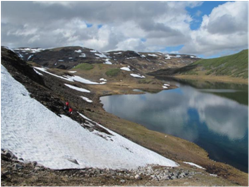 Increased demand, rising prices and security of supply concerns have resulted in a surge in global exploration for REE and other critical metals. Within Europe, Greenland is a key country in the hunt for these mineral deposits. Greenland is rich in a wide range of mineral resources and importantly, it has major areas of alkaline igneous rocks - the main hosts for a range of critical metals. These include the (Mesoproterozoic) Gardar Province in South Greenland, and the (Neoproterozoic to Mesozoic) West Greenland Carbonatite province.
Increased demand, rising prices and security of supply concerns have resulted in a surge in global exploration for REE and other critical metals. Within Europe, Greenland is a key country in the hunt for these mineral deposits. Greenland is rich in a wide range of mineral resources and importantly, it has major areas of alkaline igneous rocks - the main hosts for a range of critical metals. These include the (Mesoproterozoic) Gardar Province in South Greenland, and the (Neoproterozoic to Mesozoic) West Greenland Carbonatite province.
Picture: Studying the outcrops at ‘Banana Lake’. A pair of major faults run along the lake and out through the twin valleys in the middle ground of the photo.
The West Greenland Carbonatite province lies at the northern margin of Greenland’s Archaean Craton, which has seen repeated rifting events from Archaean through to Jurassic time, leading to the episodic generation of carbonatite magmas. Carbonatites are some of the Earth’s most unusual magmas, being dominated by carbonate minerals rather than silicates. They are also commonly enriched in a wide range of ‘incompatible’ elements, and host some of the largest known resources of critical metals such as REE and niobium (Nb).
However, developing a general genetic model that can be applied to carbonatite complexes has proved difficult. Their relationship to silicate magmas, the role of fractional crystallisation versus liquid immiscibility, the controls on metal mobility in carbonatitic magmas and fluids, and the sources of magmas, all remain relatively poorly understood, and widely variable between complexes. We know we need these elements and where they might be discovered; but how those resources come into being remains mysterious, and a challenge for Earth science.
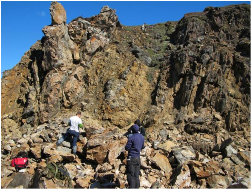 QEQERTAASAQ
QEQERTAASAQ
A Greenlandic company, Nuna Minerals A/S (www.nunaminerals.com), which owns exploration licences in Greenland, is exploring for critical metals in the West Greenland Carbonatite province. In July 2013, Adrian Finch (St Andrews University) and I were invited to join Josh Hughes, Chief Geologist of Nuna Minerals, to do fieldwork at the Jurassic-age Qeqertaasaq Phoscorite Carbonatite Complex (QPCC).
Picture: Outcrop of strongly foliated brown carbonatite dykes separated by screens of basement, near the margins of the QPCC. An undeformed, grey lamprophyre dyke cuts through from top left to lower right of the outcrop.
This work had two objectives - to understand the evolution of the complex itself, and to collect samples that would help us build a bigger picture of the magma sources and tectonic setting for the West Greenland Carbonatite province as a whole. The QPCC covers an area of around 15km2, to the north-east of Nuuk, Greenland’s capital. Our team of five was landed in this remote area by helicopter. The flight had taken us across spectacular rock platforms formed of Archaean gneiss, and in comparison with that one’s first view of the QPCC is not quite as impressive – low, rolling hills, well vegetated because of the phosphorus-rich soils that form above the Complex. Rock exposure is therefore limited, and as a result the Complex takes time to yield up its secrets.
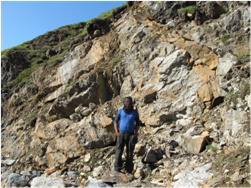 Our camp was set up in the central ‘core’ of the QPCC. The camp consisted of one tent per team member, plus a Weatherhaven portable shelter for cooking, eating and drying clothes – invaluable during the first week’s wet weather. We were surprised on our arrival to find the campsite infested by a plague of small, black caterpillars. It will be a long time before I forget the image of waking up to the sight of caterpillars crawling all over the tent fabric above my head – thankfully on the outside! It has been suggested that caterpillars similar to these might have contributed to the demise of the original Norse settlements in Greenland – and having seen for myself how they destroyed the vegetation at Qeqertaasaq, this seems only too feasible.
Our camp was set up in the central ‘core’ of the QPCC. The camp consisted of one tent per team member, plus a Weatherhaven portable shelter for cooking, eating and drying clothes – invaluable during the first week’s wet weather. We were surprised on our arrival to find the campsite infested by a plague of small, black caterpillars. It will be a long time before I forget the image of waking up to the sight of caterpillars crawling all over the tent fabric above my head – thankfully on the outside! It has been suggested that caterpillars similar to these might have contributed to the demise of the original Norse settlements in Greenland – and having seen for myself how they destroyed the vegetation at Qeqertaasaq, this seems only too feasible.
Picture: A typical outcrop of the marginal part of the carbonatite complex, with brown carbonatite sheets anastomosing through basement gneisses. The mosquito net was an essential piece of field gear!
RING DYKES
The complex had previously been mapped (Knudsen 1991) as a series of concentric carbonatite ring-dykes intruding, and metasomatising, Archaean basement gneisses. Nuna Minerals have already carried out significant drilling work in the core of the QPCC, and as a result have identified a suite of carbonatite veins enriched in REE (up to 13.2% Total Rare Earth Oxides). These veins are of particular economic interest because the REE are hosted in carbonate minerals, from which they can be easily separated in mineral processing.
 A key aim for us was to improve our understanding of the context of this mineralisation, through studying the controls on magma emplacement, and collecting a series of samples that would provide information about magma and fluid sources and element mobility. To this end, we walked across the whole of the Complex, in the process encountering several reindeer and a stunning white-tailed eagle. We amassed a vast sample suite, a substantial cairn of rocks slowly growing back at camp.
A key aim for us was to improve our understanding of the context of this mineralisation, through studying the controls on magma emplacement, and collecting a series of samples that would provide information about magma and fluid sources and element mobility. To this end, we walked across the whole of the Complex, in the process encountering several reindeer and a stunning white-tailed eagle. We amassed a vast sample suite, a substantial cairn of rocks slowly growing back at camp.
Picture: Working on the fault scarp, on typical vegetated slopes
As we worked, we developed a revised map of the Complex, during which process it became increasingly clear that syn-emplacement deformation had played a large role in the QPCC’s intrusion. The area is characterised by a suite of ENE-WSW-trending shear zones and faults that have been reactivated many times, and it is evident that these faults were important during the development of the QPCC. Most importantly from the point of view of mineralisation, we recognised that a major fault system in the south of the complex had controlled the emplacement of the carbonatite sheets associated with Nb-rich fluids. Nb mineralisation appears to extend along the length of the fault, while the REE mineralisation is focused in the area just to the north.
MOSQUITOES
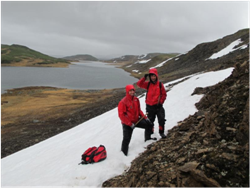 Picture: While the UK was basking in a heatwave, temperatures dropped to freezing on some days in the field
Picture: While the UK was basking in a heatwave, temperatures dropped to freezing on some days in the field
The famous Greenland storms failed to materialise, and after some initial rain, much of the trip was characterised by sunshine, blue skies and, of course, the inevitable mosquitoes. Departure from the campsite rather rushed, packing up the samples and equipment into large bags that were slung beneath a helicopter for transfer to a boat waiting on the fjord. Detailed mineralogical and geochemical investigation is now being carried out in the labs back in St Andrews, to elucidate the history of this exciting Complex and its critical metal mineralisation.
Carbonatites the world over are not well understood, and yet they contain some of our most significant resources of critical metals. The British Geological Survey, St Andrews University and Camborne School of Mines are working together with a number of other collaborators to develop research into how the critical metals are concentrated by geological processes, in carbonatites and in other settings. Work at Qeqertaasaq is an important part of this, and I’d like to thank the Geological Society very much for their support for this fieldwork.
Acknowledgements
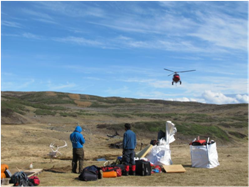 I would like to thanks Nuna Minerals for providing extensive support and logistics for our fieldwork, and the Geological Society’s Gloyne Outdoor Research Fund for additional funding. To find out more about Society fieldwork grants and how to apply, visit www.geolsoc.org.uk and look for ‘Research Grants’ in ‘About Us’.
I would like to thanks Nuna Minerals for providing extensive support and logistics for our fieldwork, and the Geological Society’s Gloyne Outdoor Research Fund for additional funding. To find out more about Society fieldwork grants and how to apply, visit www.geolsoc.org.uk and look for ‘Research Grants’ in ‘About Us’.
* Dr Kathryn Goodenough is Senior Geologist at NERC British Geological Survey, based in Edinburgh.